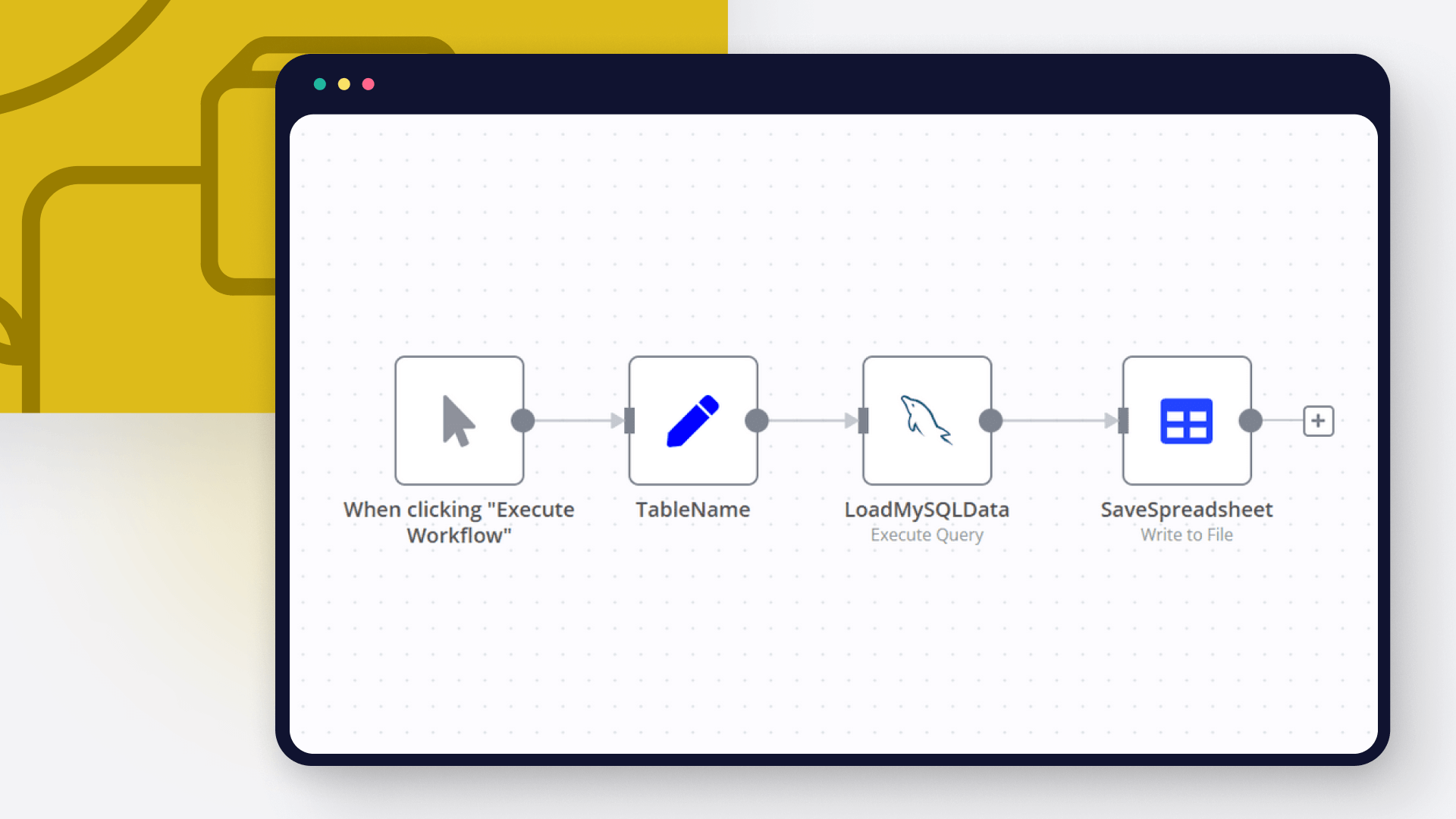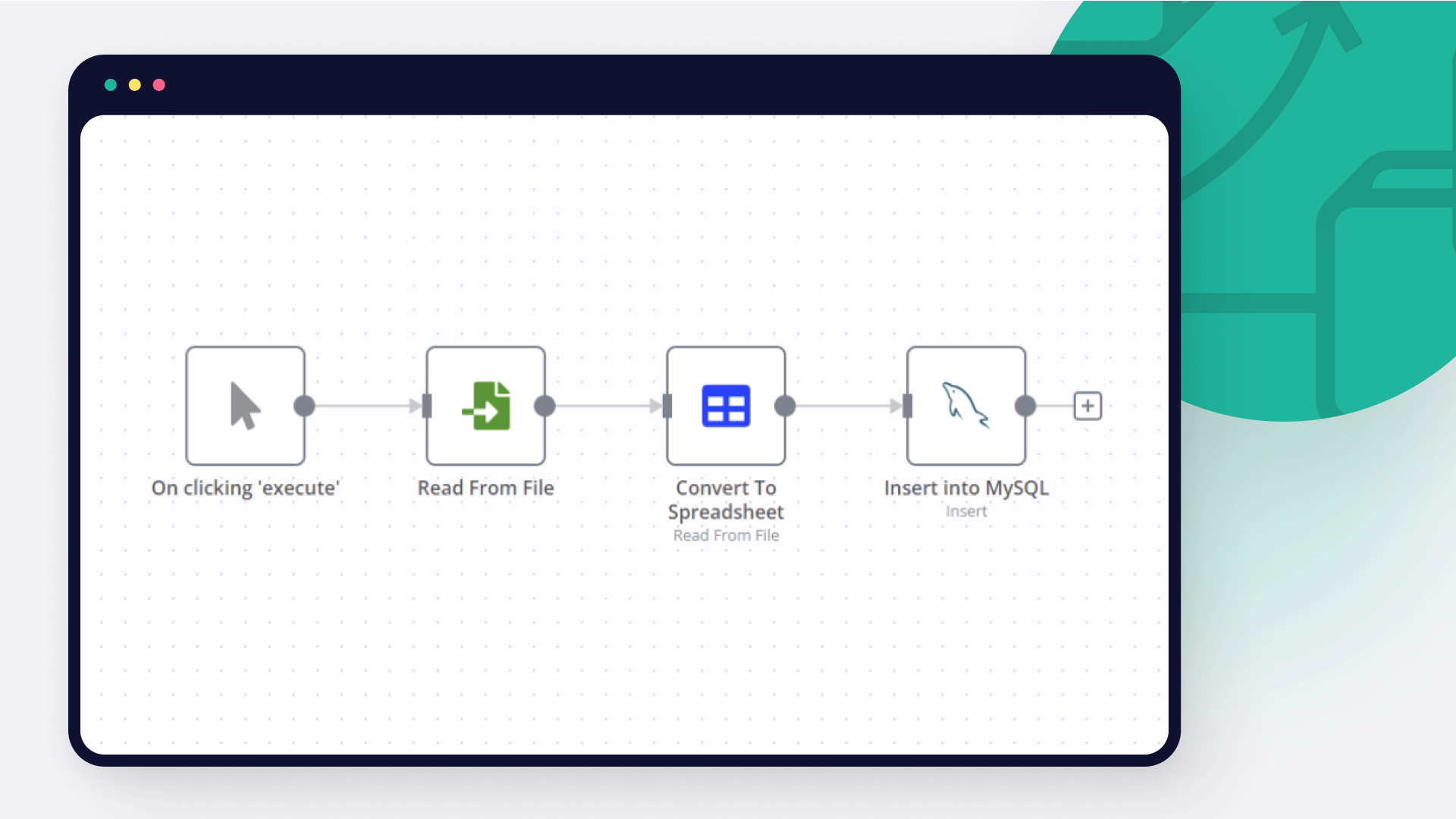MySQL and Solve Data integration

How to connect MySQL and Solve Data
Create a new workflow and add the first step
In n8n, click the "Add workflow" button in the Workflows tab to create a new workflow. Add the starting point – a trigger on when your workflow should run: an app event, a schedule, a webhook call, another workflow, an AI chat, or a manual trigger. Sometimes, the HTTP Request node might already serve as your starting point.
Build your own MySQL and Solve Data integration
Create custom MySQL and Solve Data workflows by choosing triggers and actions. Nodes come with global operations and settings, as well as app-specific parameters that can be configured. You can also use the HTTP Request node to query data from any app or service with a REST API.
MySQL supported actions
Delete
Delete an entire table or rows in a table
Execute SQL
Execute an SQL query
Insert
Insert rows in a table
Insert or Update
Insert or update rows in a table
Select
Select rows from a table
Update
Update rows in a table
Supported API Endpoints for Solve Data
List orders
Retrieve a list of orders.
Process order
Processes an order that has been created.
Cancel order
Cancels an existing order.
Return order
Processes a returned order.
Fulfill order
Marks an order as fulfilled.
Fail order fulfillment
Marks an order fulfillment as failed.
Check order fulfillment status
Checks the fulfillment status of an order.
Get payment status
Retrieves the payment status for an order.
List carts
Retrieve a list of shopping carts.
Add item to cart
Adds an item to the shopping cart.
Remove item from cart
Removes an item from the shopping cart.
List returns
Retrieve a list of returns.
List payments
Retrieve a list of payments.
List subscriptions
Retrieve a list of subscriptions.
List products
Retrieve a list of products.
List webhooks
Retrieve a list of webhooks.
List events
Retrieve a list of events.
Track email open
Tracks when an email is opened.
Queue event
Queue an event using the event input data.
List event schemas
Retrieve a list of event schemas.
Merge attributes
Merge various attributes for specified entities.
Handle cart abandoned event
Handle an event when a cart is abandoned.
Create an order
Create a new order.
Create a return
Create a new return for an item.
Delete an order
Delete an existing order.
Delete a return
Delete an existing return.
Perform search
Executes a search query.
List profiles
Retrieve the most recent profiles based on activity.
Create API Key
Create a new API Key via the GraphQL API.
List API keys
Returns all API keys as a connection object.
Create API key
Creates a new API key record and returns the created key.
Update API key
Updates an existing API key record referenced by its id.
Disable API key
Disables an existing API key record as referenced by its id.
Enable API key
Restores a currently archived API key record as referenced by its id.
Create API Key
Generates a new protected API key with a specified name.
Update API Key
Updates the name and notes of an existing API key.
Disable API Key
Disables an existing API key, preventing its use.
Enable API Key
Enables a previously disabled API key, allowing its use again.
Get Token
Gets an access token for a public API key using Basic authentication.
To set up Solve Data integration, add the HTTP Request node to your workflow canvas and authenticate it using a generic authentication method. The HTTP Request node makes custom API calls to Solve Data to query the data you need using the API endpoint URLs you provide.
See the example hereThese API endpoints were generated using n8n
n8n AI workflow transforms web scraping into an intelligent, AI-powered knowledge extraction system that uses vector embeddings to semantically analyze, chunk, store, and retrieve the most relevant API documentation from web pages. Remember to check the Solve Data official documentation to get a full list of all API endpoints and verify the scraped ones!
MySQL and Solve Data integration details
MySQL and Solve Data integration tutorials

How to work with XML and SQL using n8n
Break the boundaries of your workflow with SQL and XML in n8n. This extensive tutorial details how to export and import data, style XML with XSLT, and efficiently forward XML files for exponential productivity.

How to compare databases via the Compare Datasets node: a step-by-step tutorial
Learn to compare databases automatically, be it SQL tables or data from your favorite CRM. Grab this step-by-step tutorial with a free customizable workflow!

How to export SQL data to Excel in 3 ways
Follow this step-by-step tutorial on how to export SQL tables and queries to Excel using MS Excel itself, SSMS and n8n automation tool.

How to import CSV into MySQL: four techniques
Learn how to import CSV into MySQL databases using MySQL Workbench, SQL commands, NocoDB and n8n automation tool.

How to connect Google Sheets to MySQL: Code and no-code methods
Discover two ways to connect MySQL with Google Sheets, and learn to build no-code workflows for automating it.
FAQ
Can MySQL connect with Solve Data?
Can I use MySQL’s API with n8n?
Can I use Solve Data’s API with n8n?
Is n8n secure for integrating MySQL and Solve Data?
How to get started with MySQL and Solve Data integration in n8n.io?
Need help setting up your MySQL and Solve Data integration?
Discover our latest community's recommendations and join the discussions about MySQL and Solve Data integration.

Using variables
Mohammadali
Hi guys. I am getting certain data from my SQL database. I want to pass that data to an API. The data I get from the database contains this variable: {{ $input.item }} the problem is that I can not send the value of…
Open topic

MySQL Select and numbers
Michael Zareno
I have a MySQL table. Test data consists of an "Amount’ field, and three rows with values, 1000, My JSON input is: [ { "row_number": 2, "Amount": -1000 }, { "row_number": 3, "Amount": -52.23 }, …
Open topic

Migration error on fresh deployment of 1.45.2 in kubernetes
Neal A Richardson Sr
Describe the problem/error/question I’m trying to spin up an n8n instance in kubernetes as a fresh install. I have a database created and the connection works (it created 22 tables) but then the docker container bombs o…
Open topic

MySql node - Inserting NULL in MariaDB
GabrielBackend
Greetings, I’m trying to insert null values into my MariaDB using MySQL node. I need to use Execute SQL mode so I can call functions inside my db and do verifications in case of a update, for example IFNULL. There is n…
Open topic

Mysql node excutes for too long than we have the following error Connection lost: The server closed the connection. sql: undefined, code: PROTOCOL_CONNECTION_LOST
Chaima Belkacem
here is the error details { "errorMessage": "Connection lost: The server closed the connection.", "errorDescription": "sql: undefined, code: PROTOCOL_CONNECTION_LOST", "errorDetails": {}, "n8nDetails": { "no…
Open topic
Looking to integrate MySQL and Solve Data in your company?
The world's most popular workflow automation platform for technical teams including
Why use n8n to integrate MySQL with Solve Data
Build complex workflows, really fast


